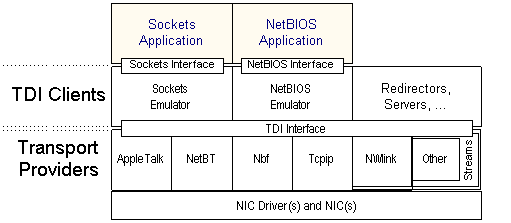3.1 The Transport Driver Interface (TDI)
Figure 3.1 shows the general relationship between TDI clients and transport
drivers.

Figure 3.1 TDI Clients and Transport Providers
As this figure shows, the Transport Driver Interface (TDI)
defines a kernel-mode network interface that is exposed at the upper edge of
all Windows NT transport protocol stacks. The highest level protocol driver in
every such stack supports the TDI interface for still higher level kernel-mode
network clients.
This interface includes the following:
-
A set of standard Windows NT kernel-mode intermediate driver Dispatch routines
exported by each TDI transport driver to which clients can submit I/O requests
(IRPs) by making calls to support routines, such as the Zw..File
routines and/or IoCallDriver
-
A set of callback routines exported by each TDI client that can be registered
with the underlying transport driver to receive notifications of specific
network events when they occur
-
Parameters, structures, IOCTLs, and procedural rules associated with these TDI
transport and client routines
-
A set of system-supplied TdiXxx functions that transports and
clients can call to aide in communication with each other
-
A set of system-supplied TdiBuildXxx macros and functions that
clients can use to set up requests to be submitted to their underlying
transports
Requiring that all Windows NT transport drivers expose a single common
interface (TDI) simplifies the task of transport driver development in that
all transports need code to support only a single defined interface. It also
simplies the task of client development by minimizing the amount of
transport-specific code that must be written.
Windows NT includes interface modules for several popular network interfaces,
such as NetBIOS and Windows Sockets. Each of these interface modules exposes a
native set of primitive functions, which are accessible through standard calls
from user mode. When called, the interface module maps the native (frequently
user-mode) function and its associated parameters and procedural rules, to one
or more calls to the underlying TDI transport driver.
Key features of TDI include the following:
-
High Level of Granularity
-
TDI accommodates all primitives and conventions from existing popular network
interfaces because it is relatively granular in nature, with several small
TDI-defined requests that can be mixed and matched to accommodate mapping from
existing network-interface functions.
-
Asynchronous Operation
-
Most kernel-mode TDI operations are asynchronous, using client-supplied
callback routines to indicate asynchronous network events as they occur and
completing most client-initiated operations submitted as IRPs asynchronously
as well.
-
32-bit Addressing and Values
-
Like all Windows NT kernel-mode components, TDI transports and their clients
are 32-bit code. All TDI-defined structures and parameters use 32-bit pointers
and values.
-
Flexible Addressing Scheme
-
TDI does not mandate any particular address format, such as the 16-character
NetBIOS name defined for legacy operating systems. Instead, it features an
extensible mechanism by which many address formats can be identified and used.
-
Extensible Communication
-
TDI defines a TDI_ACTION IOCTL request that any TDI transport can use to
support a set of transport-determined operations initiated by requests from
its clients. This allows the client to submit transport-specific requests to
the underlying transport driver that are not expressly defined by TDI.
-
Event Notification
-
TDI defines a scheme by which transports can notify their clients of
interesting events that occur on the network without requiring the client to
submit an explicit I/O request. For certain types of events, such as connects,
disconnects, and receives, the transport driver can indicate data along with
the event notification when it calls its client with such a notification.
The following features can be supported by a TDI transport driver as
additional options:
-
Data Transfer Modes
-
TDI supports sending and receiving data as discrete messages (message mode) or
as a stream of bytes (byte-stream mode). Support for either mode (or both)
depends on the transport driver writer and/or on the nature of the protocol.
-
Internal Buffering
-
TDI transports can buffer their client's sends and receives internally.
Transport-internal buffering allows the TDI client to set and query driver
internal buffer sizes, request nonblocking send operations, receive
notification of available buffer space, and look at (peek) buffered
data before receiving it.
-
Management Options
-
All transports maintain some TDI-defined state about their respective
features, limits, and runtime statistics. This allows each client to
dynamically query and, in some cases to set, transport-provider static
information, statistics, and configuration parameters. In addition, the
extensible TDI_ACTION IOCTL, mentioned previously, allows any TDI transport
driver to implement unique network-management features that can be accessed by
its clients through action requests to the transport.
-
Quality of Service (QOS)
-
TDI transports can provide QOS negotiation upon establishment of a network
connection. In addition, such a driver can support QOS for connectionless
datagram transmission. To support either, TDI-defined connection-establishment
and datagram-send requests include Options and OptionsLength
parameters that allow a TDI client to include a transport-specific,
variable-length counted string specifying QOS options.
In fact, the Options and OptionsLength parameters can be used to
pass any transport-specific connection- or datagram-related options to the
transport driver at the discretion of the driver writer, not just QOS
specifications.
-
Expedited Delivery
-
When sending messages, the client can flag particular messages as expedited.
At the sending side, the underlying transport sends these messages ahead of
non-expedited messages. At the receiving side, expedited messages are
indicated to the client before and/or separate from non-expedited messages.
-
Chained Receive Indications
-
If the underlying NDIS drivers support multipacket receive indications, a TDI
transport can give its clients direct read-only access to a full TSDU in a
single call, and the client can retain control of the buffer containing the
TSDU until it has consumed the indicated data. This feature improves the
performance of both transport and client by cutting down on call overhead for
receive indications.

